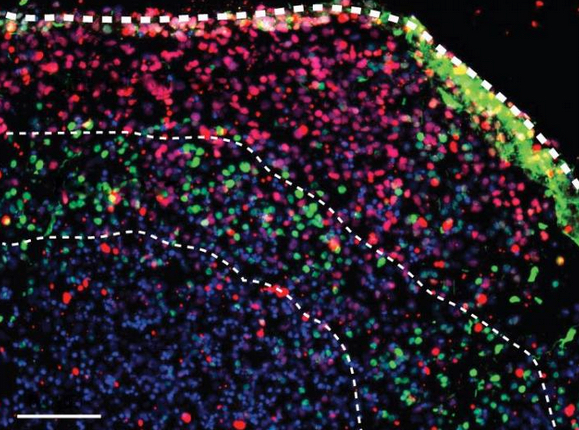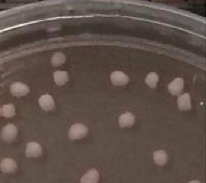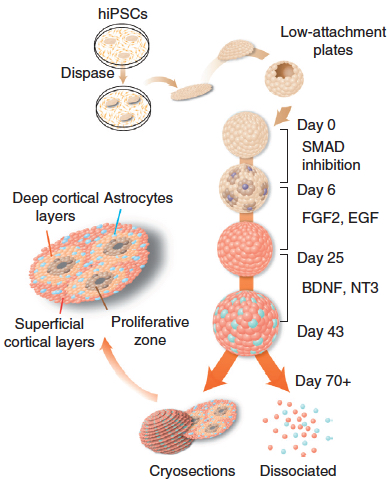A 3-D human ‘organoid’ brain in a dish
June 12, 2015

“It’s alive!” Generated from stem cells, neurons and supporting cells in artificial “human cortical spheroids” form layers, organizing themselves like the architecture of the developing human brain and networking with each other (credit: Sergiu Pasca, M.D., Stanford University)
Sergiu Pasca, M.D., of Stanford University and colleagues have developed “human cortical spheroids” — miniature cultured 3-D structures that grow and function much like the cortex of the brain of the person from whom they were derived.
These “organoids” (3-D complexes of cells that function like an organ) buzz with neuronal network activity. Cells talk with each other in circuits, much as they do in our brains. They network.

Budding brain-like “human cortical spheroids” growing in a petri dish (credit: Sergiu Pasca, M.D., Stanford University)
“There’s been amazing progress in this field over the past few years,” said Thomas R. Insel, M.D., Director of the NIH’s National Institute of Mental Health, which provided most of the funding for the study. “The cortex spheroids grow to a state in which they express functional connectivity, allowing for modeling and understanding of mental illnesses. They do not even begin to approach the complexity of a whole human brain. But that is not exactly what we need to study disorders of brain circuitry.”
Improved stem cells lead to more functional neurons and connections

Generating human cortical spheroids from human induced pluripotent stem cells (hiPSCs) (credit: Anca M Paşca et al./Nature Methods)
Prior to the new study, scientists had developed a way to study neurons differentiated from stem cells derived from patients’ skin cells — using a technology called induced pluripotent stem cells (iPSCs).
They had even produced primitive organoids by coaxing neurons and support cells to organize themselves, mimicking the brain’s own architecture. But these lacked the complex circuitry required to even begin to mimic the workings of our brains.
Now, based on an improved, streamlined method for producing iPSCs, the cortex-like spheroids developed by Pasca’s team harbor healthier neurons supported by a more naturalistic network of supporting glial cells. The result: more functional neural connections and circuitry.
Like the developing brain, the neurons form layers and talk with each other via neural networks. The spheroid technology is more consistent than earlier organoids in generating the same kinds of cortex-like structures in repeated experiments.
The budding cortex also lends itself to analysis using conventional brain slice methods. In a “science fiction” future, the scientists speculate, a cortex created from a person’s cell scrapings — Gattaca style — might potentially reveal what circuits went awry in the developing cortex of a person with a brain disorder, leading to a cure.
“While the technology is still maturing, there is great potential for using these assays to more accurately develop and test safety and effectiveness of new treatments before they are used in individuals with a mental illness,” said David Panchision, Ph.D., NIMH program director for stem cell research.
What’s next? Perhaps development of multiple neuron subtypes that normally populate the cortex, as well as long-distance connections between this cortex-like structure and other — yet to be developed — organoid structures, the researchers say.
The research was described in May 25, 2015 online in the journal Nature Methods.
National Institute of Mental Health (NIMH) | iPS Cells & Organoids – Sci-Fi vs Reality
Abstract of Functional cortical neurons and astrocytes from human pluripotent stem cells in 3D culture
The human cerebral cortex develops through an elaborate succession of cellular events that, when disrupted, can lead to neuropsychiatric disease. The ability to reprogram somatic cells into pluripotent cells that can be differentiated in vitro provides a unique opportunity to study normal and abnormal corticogenesis. Here, we present a simple and reproducible 3D culture approach for generating a laminated cerebral cortex–like structure, named human cortical spheroids (hCSs), from pluripotent stem cells. hCSs contain neurons from both deep and superficial cortical layers and map transcriptionally to in vivo fetal development. These neurons are electrophysiologically mature, display spontaneous activity, are surrounded by nonreactive astrocytes and form functional synapses. Experiments in acute hCS slices demonstrate that cortical neurons participate in network activity and produce complex synaptic events. These 3D cultures should allow a detailed interrogation of human cortical development, function and disease, and may prove a versatile platform for generating other neuronal and glial subtypes in vitro.